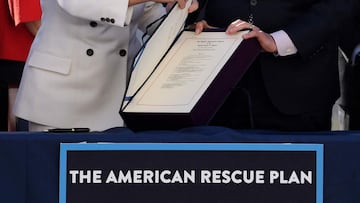Can I get a third stimulus money if I get unemployment benefits?
The American Rescue Plan signed into law by President Joe Biden will extend unemployment benefits and get millions of Americans a $1,400 stimulus check.

As the US begins to see the light at the end of the tunnel with the number of vaccinations steadily increasing and the number of infections dropping the economy may begin to heal. To help speed up the recovery and hold struggling Americans over until the pandemic is defeated, congressional Democrats passed President Joe Biden’s $1.9 trillion covid-19 relief bill the American Rescue Plan.
Two features of the bill will help prop up household finances, one in the short term and the other through to Labor Day. The White House has said that the first wave of $1,400 stimulus checks will begin appearing in American's bank accounts as soon as this weekend. US Workers who are jobless can now expect unemployment benefits to continue through to early September, that were set to expire 14 March.
Can you receive a stimulus check while on unemployment?
The two provisions in the pandemic relief bill are not mutually exclusive, just because you receive one does not mean you can’t receive the other. In many cases both will be necessary to shore up the finances of households across the nation.
Whereas the direct stimulus payments will be sent out by the Internal Revenue Service (IRS) the federal pandemic unemployment benefits will be distributed by state unemployment agencies. The former is a refundable tax credit for 2021 paid in advance and the latter taxable income.
-
Biden signs the American Rescue Plan into law
-
How will the new stimulus check payments be sent?
-
Are unemployment benefits included in the new relief bill package?
-
White House expects IRS to start issuing checks in March
-
How to find out if you’ll get a third stimulus check
Eligibility for the third stimulus check
As with the previous two rounds of direct stimulus payments, in the third round individuals who have an adjusted gross income (AGI) of $75,000, couples making $150,000, or heads of household earning $112,500, plus their children or adult dependents, qualify for the full $1,400 per person. Mixed-status households, where members have different citizenship but at least one person has a Social Security Number, are also eligible for a payment.
However, above those income thresholds, the direct stimulus payment amounts will phase out much faster than in the previous two rounds. An individual with an AGI of $80,000, a couple making $160,000, or a head of household earning $120,000 won’t see any stimulus money. This was a last-minute deal to keep moderate Democrats on board who wanted to more narrowly target the direct stimulus payments.
Congress has officially passed President Biden’s American Rescue Plan. How will this help you and your family? Head to https://t.co/80skBjycjD to learn more. https://t.co/l4LsCA4UGx
— The White House (@WhiteHouse) March 11, 2021
Extended unemployment benefits
The unemployed will receive a $300 weekly boost to jobless aid that will continue until 6 September, along with other federal pandemic unemployment benefits.
Mixed-Earner Unemployment Compensation will provide an extra $100 per week for those whose income is a mix of self-employed, 1099 income, and wages paid by their employer, W-2 income. This jobless aid will continue until 6 September.
There is also an extension to the Pandemic Unemployment Assistance (PUA) program, which covers the self-employed, gig workers, part-timers and others who are not able to receive regular state unemployment benefits. Pandemic Emergency Unemployment Compensation (PEUC) for the long term out of work is available until 6 September as well and both are capped at a cumulative total of 79 weeks, up from 50.
Unemployment benefits: how to apply
To apply for the benefit payments you need to file a claim with the unemployment insurance program in the state where you last worked. States have their own procedures for doing so, but can usually be filed in person, by telephone, or online.
Here we provide some general tips to get started.
- As soon as possible after you become unemployed, you should contact your state's unemployment insurance programme.
- The claim should usually be made with the state where you last worked. If you worked in a state other than the one where you now live or if you worked in multiple states, the state unemployment insurance agency where you now live can provide information about how to file your claim with other states.
- To file the claim you will need addresses and dates of your former employment, so be sure to give the correct information to avoid delays.
Related stories
You can find the contact information for your state's unemployment office on the Department of Labor Online Portal.
Stimulus relief bill: latest news
For all of the latest updates on the stimulus checks and tax credits as they happen, follow our dedicated live feed.
- Coronavirus stimulus checks
- USA coronavirus stimulus checks
- IRS
- Covid-19 economic crisis
- Unemployment compensation
- Science
- Coronavirus Covid-19
- Economic crisis
- Unemployment
- Taxes
- Pandemic
- Coronavirus
- Recession
- Inland Revenue
- Economic climate
- Virology
- Outbreak
- Infectious diseases
- Employment
- Tributes
- Microbiology
- Diseases
- Public finances
- Medicine
- Economy
- Health
- Finances
- Life sciences
- Biology


